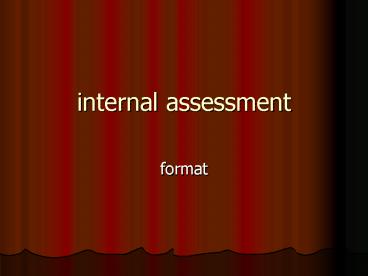internal assessment PowerPoint PPT Presentation
1 / 16
Title: internal assessment
1
internal assessment
- format
2
introduction
The historical investigation is a problem-solving
activity which enables candidates to demonstrate
the application of their skills and knowledge to
a specific topic.
3
The emphasis must be on a specific historical
enquiry tied to classroom activities that enables
the candidate to develop and apply the skills of
a historian, such as making sense of source
material and managing conflicting
interpretations. The activity demands that
candidates search for, select, evaluate and use
evidence to reach a decision or solve a problem.
4
The investigation is not a major piece of
researchcandidates are only required to evaluate
two of the sources they have used.
5
The account should not be written up as an essay
but in the style outlined later in this section.
The internal assessment allows for flexibility
and should encourage candidates to use their own
initiative.
6
parts of paper
A Plan of the investigation B Summary of
evidence C Evaluation of sources D Analysis E
Conclusion F List of sources
7
A Plan of the investigation
The plan of the investigation should
include the subject of the investigation which
may be formulated as a question the methods to
be used in the investigation
8
B Summary of evidence
The summary of evidence should indicate what the
candidate has found out from the sources he or
she has used. It can be in the form of either a
list or continuous prose. Any illustrations,
documents, or other relevant evidence should be
included in an appendix and will not be included
in the word count.
9
C Evaluation of sources
This section of the written account should be a
critical evaluation of two important sources
appropriate to the investigation and should refer
to their origin, purpose, value and limitation.
More than two sources may be evaluated but the
emphasis should be on the thorough evaluation of
two sources rather than a superficial evaluation
of a greater number.
10
D Analysis
The analysis should include the importance of
the investigation in its historical
context analysis of the evidence if
appropriate, different interpretations.
11
E Conclusion
The conclusion must be clearly stated and
consistent with the evidence presented.
12
F List of sources
A bibliography or list of sources must be
included although this will not form part of the
word count.
13
footnotes
First Footnote example Gary Nash, Red, White and
Black The Peoples of North America (New York
Times, 2000) 245. Second Footnote Nash, 245.
books
14
chapters in
books
First Footnote example J. Murrin, Beneficiaries
of Catastrophe in New American History ed. Eric
Foner (New York Times, 2000) 245. Second
Footnote Murrin, 245.
15
journals
articles
First Footnote example J. Axtell, A North
American Perspective for Colonial History.
Journal of American History, Vol. 1, No. 1,
November 2005, 245-255. Second Footnote Axtell,
245.
16
audio
multimedia
Footnote example Peter Weir (director),
Gallipoli (video recording), Sydney, 1981.

